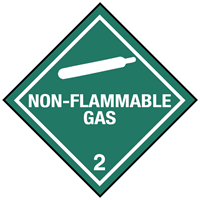
 Print
Print
Chemical Datasheet
OXYGEN |


|
Chemical Identifiers
| CAS Number |
UN/NA Number |
DOT Hazard Label |
USCG CHRIS Code |
|
|
|
- Non-Flammable Gas
- Oxidizer
|
|
| NIOSH Pocket Guide |
International Chem Safety Card |
|
none
|
- OXYGEN
- OXYGEN (LIQUEFIED)
|
NFPA 704
General Description
Oxygen is a colorless, odorless and tasteless gas. It will support life. It is noncombustible, but will actively support the burning of combustible materials. Some materials that will not burn in air will burn in oxygen. Materials that burn in air will burn more vigorously in oxygen. As a non-liquid gas it is shipped at pressures of 2000 psig or above. Pure oxygen is nonflammable. Under prolonged exposure to fire or intense heat the containers may rupture violently and rocket. Oxygen is used in the production of synthesis gas from coal, for resuscitation and as an inhalant.
Hazards
Reactivity Alerts
Air & Water Reactions
No rapid reaction with air. No rapid reaction with water.
Fire Hazard
Behavior in Fire: Increases intensity of any fire. Mixtures of liquid oxygen and any fuel are highly explosive. (USCG, 1999)
Health Hazard
Inhalation of 100% oxygen can cause nausea, dizziness, irritation of lungs, pulmonary edema, pneumonia, and collapse. Liquid may cause frostbite of eyes and skin. (USCG, 1999)
Reactivity Profile
Propellant; ignites upon contact with alcohols, alkali metals, amines, ammonia, beryllium alkyls, boranes, dicyanogen, hydrazines, hydrocarbons, hydrogen, nitroalkanes, powdered metals, silanes, or thiols [Bretherick 1979. p.174]. Heat of water will vigorously vaporize liquid oxygen, pressures may build to dangerous levels if this occurs in a closed container. Liquid oxygen gives a detonable mixture when combined with powdered aluminum [NFPA 491M. 1991].
Belongs to the Following Reactive Group(s)
Potentially Incompatible Absorbents
Use caution: Liquids with this reactive group classification have been
known to react with the
absorbents
listed below.
- Cellulose-Based Absorbents
- Expanded Polymeric Absorbents
Response Recommendations
Isolation and Evacuation
Excerpt from ERG Guide 122 [Gases - Oxidizing (Including Refrigerated Liquids)]:
IMMEDIATE PRECAUTIONARY MEASURE: Isolate spill or leak area for at least 100 meters (330 feet) in all directions.
LARGE SPILL: Consider initial downwind evacuation for at least 500 meters (1/3 mile).
FIRE: If tank, rail tank car or highway tank is involved in a fire, ISOLATE for 800 meters (1/2 mile) in all directions; also, consider initial evacuation for 800 meters (1/2 mile) in all directions. (ERG, 2024)
Firefighting
Excerpt from ERG Guide 122 [Gases - Oxidizing (Including Refrigerated Liquids)]:
Use extinguishing agent suitable for type of surrounding fire.
SMALL FIRE: Dry chemical or CO2.
LARGE FIRE: Water spray, fog or regular foam. If it can be done safely, move undamaged containers away from the area around the fire. Damaged cylinders should be handled only by specialists.
FIRE INVOLVING TANKS: Fight fire from maximum distance or use unmanned master stream devices or monitor nozzles. Cool containers with flooding quantities of water until well after fire is out. Do not direct water at source of leak or safety devices; icing may occur. Withdraw immediately in case of rising sound from venting safety devices or discoloration of tank. ALWAYS stay away from tanks in direct contact with flames. For massive fire, use unmanned master stream devices or monitor nozzles; if this is impossible, withdraw from area and let fire burn. (ERG, 2024)
Non-Fire Response
Excerpt from ERG Guide 122 [Gases - Oxidizing (Including Refrigerated Liquids)]:
Keep combustibles (wood, paper, oil, etc.) away from spilled material. Do not touch or walk through spilled material. Stop leak if you can do it without risk. If possible, turn leaking containers so that gas escapes rather than liquid. Do not direct water at spill or source of leak. Use water spray to reduce vapors or divert vapor cloud drift. Avoid allowing water runoff to contact spilled material. Prevent entry into waterways, sewers, basements or confined areas. Allow substance to evaporate. Isolate area until gas has dispersed. CAUTION: When in contact with refrigerated/cryogenic liquids, many materials become brittle and are likely to break without warning. (ERG, 2024)
Protective Clothing
Safety goggles or face shield; insulated gloves; long sleeves; trousers worn outside boots or over high-top shoes to shed spilled liquid. (USCG, 1999)
DuPont Tychem® Suit Fabrics
No information available.
First Aid
INHALATION: in all but the most severe cases (pneumonia), recovery is rapid after reduction of oxygen pressure; supportive treatment should include immediate sedation, anticonvulsive therapy if needed, and rest.
EYES: treat frostbite burns.
SKIN: treat frostbite; soak in lukewarm water. (USCG, 1999)
Physical Properties
Flash Point: data unavailable
Lower Explosive Limit (LEL): data unavailable
Upper Explosive Limit (UEL): data unavailable
Autoignition Temperature: data unavailable
Melting Point:
-361°F
(USCG, 1999)
Vapor Pressure: data unavailable
Vapor Density (Relative to Air): data unavailable
Specific Gravity:
1.14
at -297.4°F
(USCG, 1999)
- Denser than water; will sink
Boiling Point:
-297.3°F
at 760 mmHg
(USCG, 1999)
Molecular Weight:
32
(USCG, 1999)
Water Solubility: data unavailable
Ionization Energy/Potential: data unavailable
IDLH: data unavailable
AEGLs (Acute Exposure Guideline Levels)
No AEGL information available.
ERPGs (Emergency Response Planning Guidelines)
No ERPG information available.
PACs (Protective Action Criteria)
No PAC information available.
Regulatory Information
EPA Consolidated List of Lists
No regulatory information available.
CISA Chemical Facility Anti-Terrorism Standards (CFATS)
No regulatory information available.
OSHA Process Safety Management (PSM) Standard List
No regulatory information available.
Alternate Chemical Names
- LIQUID OXYGEN
- LOX
- OXYGEN
- OXYGEN, (LIQUID)
- OXYGEN, COMPRESSED
- OXYGEN, [COMPRESSED]



 Print
Print

